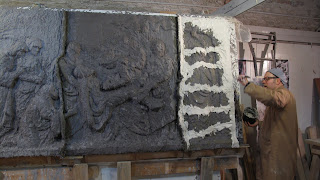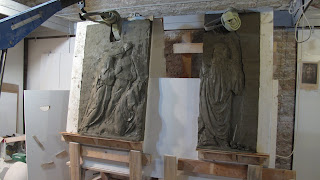We wish to express our gratitude for this opportunity to all of the people involved in Backnang: Dr. Roland Idler, Christa Breuninger, Reginald Kunzelmann and Gunther Wolf. A special thank you to Renzo Ravagnan of the Istituto Veneto per i beni culturali. Without his generous support this project would not have been possible.
This blog records the processes involved in the creation of a marble sculpture.
Monday, September 5, 2011
 The left panel is getting close to being finished. At this stage I am carefully studying the subtle shadows. These need to be in harmony with the forms on the other two panels. In our studio the morning light is the best. In the afternoon the light reflects off the floor and makes it difficult to see the forms of the sculpture.
The left panel is getting close to being finished. At this stage I am carefully studying the subtle shadows. These need to be in harmony with the forms on the other two panels. In our studio the morning light is the best. In the afternoon the light reflects off the floor and makes it difficult to see the forms of the sculpture.Saturday, July 9, 2011
Friday, July 8, 2011
Sunday, April 10, 2011
Thursday, March 24, 2011
Wednesday, March 23, 2011
Tuesday, March 22, 2011
making the waste mold
Monday, March 21, 2011
Relief for a chapel in Backnang, Germany
 In October of last year I received notice that an organization in Backnang, Germany was interested in creating a relief sculpture in marble. An original sculpture had been lost many years ago and someone found a picture of this in the archives of the chapel that held the sculpture. I was asked to use the original image and create a sculpture. This sculpture was created by an artist name Schnabel around 1884.
In October of last year I received notice that an organization in Backnang, Germany was interested in creating a relief sculpture in marble. An original sculpture had been lost many years ago and someone found a picture of this in the archives of the chapel that held the sculpture. I was asked to use the original image and create a sculpture. This sculpture was created by an artist name Schnabel around 1884.This blog is a record of the different processes involved in the creation of this artwork.
Here you see the black and white image enlarged to the desired size.
Subscribe to:
Posts (Atom)








































